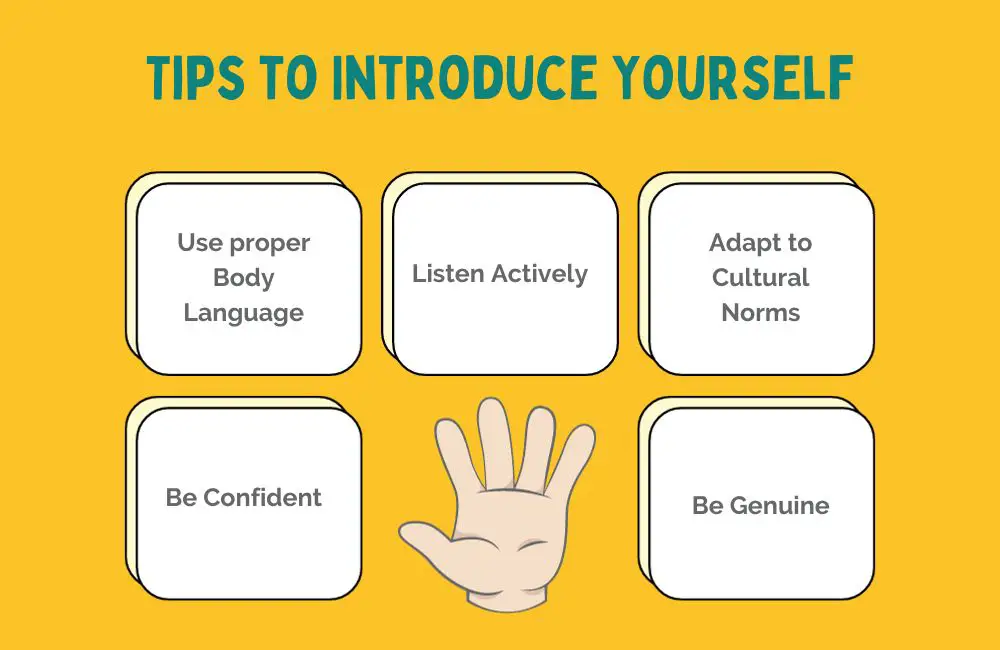This article covers the following areas –
- Introducing Yourself in Formal Situations
- Introducing Yourself in Informal Situations
- 5 Tips to Introduce Yourself in English
- Final Thoughts
- FAQ: Introducing Yourself in English
Introducing yourself in English, formal or informal, is an essential skill, especially in diverse social and professional settings. Let’s explore how you can do this effectively in both scenarios.
To introduce yourself in English, start with a polite greeting, state your name, and mention your role or affiliation. For formal settings, add professional details; in casual contexts, share personal interests. Use confident body language, maintain eye contact, and be genuine in your approach.
Continue reading to explore detailed tips and nuances for effective introductions in various contexts, enhancing your communication skills in diverse social and professional settings.
Well! If you are looking for a book or a guide to help you learn and improve your English, you may try English Made Easy Volume One: A New ESL Approach: Learning English Through Pictures (Amazon Link). This book creatively uses pictures and text in tandem to revolutionize English language learning, making it easier to understand and more effective overall.
Introducing Yourself in Formal Situations
To introduce yourself formally in English, start with a polite greeting like “Good morning/afternoon.” State your full name and professional role or affiliation. Briefly mention the purpose of your introduction and add relevant details. Conclude with a respectful closing remark.

In formal settings, like business meetings, interviews, or academic environments, it’s important to be concise and clear while showing respect and professionalism.
1. Start with a Greeting
When introducing yourself formally, it is essential to begin with a polite greeting. This sets a respectful tone and grabs the listener’s attention.
Common greetings include “Good morning,” “Good afternoon,” or a simple “Hello.” The choice of greeting can depend on the time of day and the formality of the situation.
For instance, in a business meeting, “Good morning” or “Good afternoon” is more appropriate, whereas “Hello” might be suitable for less formal settings.
2. Share Full Name
After the initial greeting, state your full name. This is particularly important in formal settings where clear identification is essential.
In very formal situations, you might include a title, such as “Dr.” or “Mr./Ms.,” before your name. This helps set a professional tone and hints at your educational or professional background. For instance, using “Dr.” indicates high academic achievement.
3. Tell Your Professional Affiliation
Next, mention your professional role or affiliation. This provides context to your introduction and helps the listener understand your background and expertise.
For example, you might say, “I am the Marketing Manager at XYZ Corporation,” or “I am a graduate student at ABC University.” This step is crucial, especially when meeting someone in a professional setting for the first time, as it helps establish your professional identity.
4. Explain the Purpose of the Introduction
Briefly mention the reason for your introduction. This is where you align the listener with the purpose of the meeting or interaction.
For example, “I’m here to discuss the new marketing strategy” or “I’m presenting my research on renewable energy.”
This helps to set the agenda and gives the listener a clear idea of what to expect from the conversation or presentation.
5. Add Some Additional Details
Depending on the context and the audience, you might want to add more details about your professional background or the specific purpose of your meeting.
This could include your experience in the field, any special achievements, or specific aspects of your work relevant to the interaction. However, keep this part concise to maintain the attention and interest of your audience.
6. Ensure a Polite Closure
End your introduction with a polite remark. This could be an expression of gratitude, such as “Thank you for the opportunity to introduce myself,” or a forward-looking statement, like “I’m looking forward to working with you.”
This concludes your introduction positively and demonstrates your eagerness and readiness for the upcoming interaction or collaboration.
Now, based on the guidelines provided above, my introduction may look like something like this. What about yours? Let us all know about each other in the comment section.
Good afternoon, I’m Niaj A A Khan, an ESL Expert. I specialize in innovative teaching methodologies for language acquisition. My purpose today is to share insights and strategies for effective ESL education. With a background in classroom teaching and curriculum development, I comprehensively understand the challenges and opportunities in ESL education. Thank you for discussing how we can enhance language learning experiences together.
Introducing Yourself in Informal Situations
An informal English introduction starts with a casual greeting like “Hi” or “Hello,” followed by your first name. Share a personal interest or connection to spark conversation, and invite the other person to engage with a friendly question or comment.

The tone is relaxed and friendly in casual settings like parties, informal gatherings, or networking events. Let’s learn in more detail.
1. Greet Casually
Starting with a casual greeting in an informal introduction sets a relaxed and friendly tone. Common greetings such as “Hi,” “Hey,” or “Hello” are perfect for this. The choice of greeting can depend on your style and the context of the meeting. A casual greeting immediately signals the interaction is friendly and laid-back, making it ideal for social settings.
2. Share Only First Name
In informal situations, using just your first name is usually enough. It makes the interaction more personal and approachable. Saying something like “I’m [First Name]” is simple yet effective. This approach is particularly suitable in casual gatherings where the atmosphere is more about making connections than exchanging formal credentials.
3. Talk about Personal Connection
Mentioning a mutual acquaintance or a relevant connection can be a great conversation starter. It creates a common ground and makes the interaction more engaging. For example, saying “I’m a friend of [Mutual Friend’s Name]” or “We met at [Event or Place].” This helps to establish a connection and can make the conversation flow more naturally.
4. Express Interest or Fun Fact
Sharing something about your interests or a fun fact about yourself can spark an interesting conversation. It could be a hobby, a recent travel experience, or something unique about your background. For instance, “I’m really into hiking and photography.” This makes the introduction more memorable and opens up the conversation for mutual interests.
5. Use Open-Ended Question
Ending with an open-ended question invites the other person into the conversation. It shows your interest in them and encourages a two-way dialogue. Questions like “What brings you here today?” or “Do you have any hobbies?” are great for this purpose. This step is crucial in making the introduction feel like the start of a conversation rather than just a statement about yourself.
6. Ensure Friendly Closure
Conclude your introduction with a friendly remark or a smile. This can be as simple as “Nice to meet you!” or “I’m glad we had a chance to chat.” A friendly closure leaves a positive impression and sets the tone for a pleasant interaction.
Based on the guidelines above, my introduction in an informal setting may look like this.
Hi, I’m Niaj. I’m here with my colleague Sara, who’s wearing the blue scarf. I’m passionate about ESL teaching and enjoy exploring new cultures through language. What about you? Do you have any interests or hobbies you’re passionate about?
Now it’s your turn! How would you introduce yourself informally? Share in the comments, and let’s get to know each other in a fun, casual way!
5 Tips to Introduce Yourself in English
In formal or informal settings, introducing oneself effectively in English is an essential skill. Mastering this art requires more than just verbal communication; it involves a combination of body language, active listening, cultural sensitivity, confidence, and authenticity.

Well, before moving forward, I would like to share about a book that can help you improve your conversational skills. 110 Real Life English Conversations (Amazon Link) is a great book for ESL learners and teachers, providing various conversation and situational dialogues, 223 everyday English expressions, and idioms. It’ll certainly help you to gain the confidence to speak English in real life.
Use proper Body Language
Body language is a crucial aspect of both formal and informal introductions. It communicates confidence and approachability.
In formal settings, a firm handshake signifies professionalism and respect. Eye contact is essential in both scenarios as it conveys attention and sincerity. A warm smile, regardless of the setting, helps to create a friendly and open atmosphere. Remember, your body language often speaks as loudly as your words.
Listen Actively
After introducing yourself, giving the other person your full attention is important. Active listening involves maintaining eye contact, nodding, and reacting appropriately to what the other person is saying. This not only shows respect but also helps build rapport. It’s about showing that you are genuinely interested in what they say, which is vital in formal and informal interactions.
Adapt to Cultural Norms
Awareness of cultural differences is key, especially in international or diverse settings. Different cultures have different norms for introductions and interactions. For instance, the appropriate distance to maintain, the level of direct eye contact, and how to address someone can vary widely.
Being sensitive and adaptable to these norms shows respect and cultural awareness, which is highly appreciated in both formal and informal settings.
Be Confident
Confidence is about speaking clearly and at a moderate pace, showing that you are comfortable and self-assured. However, it’s crucial to strike a balance and avoid appearing arrogant.
In a formal introduction, confidence reflects your professionalism; in an informal setting, it makes you seem more approachable. Confidence can be practiced and improved over time, significantly impacting how others perceive you.
Be Genuine
Authenticity is the key to a memorable introduction. People are generally more receptive to someone who comes across as genuine and sincere. This means being true to yourself in how you speak and act.
While professionalism is crucial in formal situations, it doesn’t mean you can’t be personable. In informal settings, being genuine helps create a relaxed and comfortable environment. Authenticity builds trust and facilitates better connections.
Remember, the way you introduce yourself can set the tone for the entire interaction, so it’s worth paying attention to these aspects.
Final Thoughts
mastering the art of introducing yourself in English, both formally and informally, is a key interpersonal skill. It involves the right words, appropriate body language, cultural sensitivity, and authenticity.
Whether in a boardroom or a social gathering, a well-crafted introduction sets the stage for meaningful interactions and lasting impressions. By adapting these guidelines to your specific context, you can navigate introductions with confidence and ease.
If you have further questions or suggestions about anything specific related to this topic or anything else related to learning English as a second language, feel free to ask me in the comment box. You may also help the ESLA community by putting your valuable suggestions here to help every member improve their English language skills.
FAQ: Introducing Yourself in English
1. What are some basic phrases for introducing myself in a formal setting?
In formal settings, use phrases like “Hello, my name is [Your Name],” or “Good [morning/afternoon/evening], I’m [Your Name], [Your Position or Relation].” Keep it simple and professional.
2. How should I introduce myself informally?
In informal settings, it’s often appropriate to be more relaxed. You can simply say, “Hi, I’m [Your Name],” or even “Hey there, I’m [Your Name].”
3. Should I offer a handshake when introducing myself?
In many cultures, a handshake is a standard part of a formal introduction. However, be mindful of cultural differences and current health guidelines. In informal situations, a handshake may be less necessary.
4. How can I make my introduction more memorable?
Add a unique detail or a friendly smile. For example, “Hello, I’m [Your Name], the one who recently moved from [City/Country]” or “I’m [Your Name], I’m passionate about [Hobby/Interest].”
5. Is it important to make eye contact when introducing myself?
Yes, making eye contact is considered important in formal and informal settings as it conveys confidence and sincerity.
6. How can I introduce myself in a group setting?
In a group, wait for the right moment and then introduce yourself to the group as a whole. You might say, “Hi everyone, I don’t think we’ve met yet. I’m [Your Name].”
7. What if I forget someone’s name immediately after they introduce themselves?
It’s okay to ask again politely. You can say, “I’m sorry, could you remind me of your name?” It shows you’re genuinely interested in getting to know them.
8. Should I mention my job or profession in every introduction?
In formal settings, it’s often relevant. In informal settings, gauge the context; mentioning interests or mutual connections might be more appropriate.
9. How can I respond if I don’t catch someone’s name during an introduction?
Politely ask them to repeat it. Saying something like, “I’m sorry, I didn’t catch your name,” is perfectly acceptable.
10. Is it okay to use humor when introducing myself?
In informal settings, light humor can be a good icebreaker. It’s best to stick to a straightforward introduction in formal situations unless the context is relaxed.






